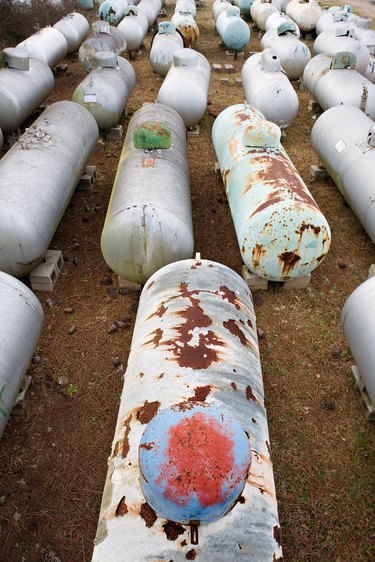
Many homes have liquefied petroleum (LP) tanks because the homeowners use this type of gas for heating. It's also commonly used for cooking, hot water heaters and other appliances. This type of gas is derived from natural gas and petroleum. Although it's costly to get a tank filled up, liquefied petroleum is usually cheaper than other heating sources in the long run. A 500-gallon tank can fuel a typical family's home for a year.
What Is an LP Tank?
Video of the Day
An LP tank is also called "LPG-liquefied petroleum gas," "LP gas" or a "Propane Gas" tank. Liquefied petroleum comes to your home in the form of a really cold liquid. It's pumped into a storage tank then converted to a gas inside the tank, which is how it comes into your home, via the supply line. Liquefied petroleum tanks are commonly painted white or silver. These colors reflect heat and help keep the tanks cooler.
Video of the Day
How to Recognize the Smell of Liquefied Petroleum
In its unadulterated form, you can't see or smell liquefied petroleum. That's why manufacturers put a chemical in the original liquid to give it a foul odor. That way, leaks can be detected easier. The gas has a strong, stinky odor that's compared to the sulfurous smell of rotten eggs, a skunk or even a dead animal.
Dangers Associated with a Propane Tank
In its liquid form, liquefied petroleum is so cold that it can cause severe frostbite to your skin. If liquefied petroleum leaks out, it's in gas form, so it's not a threat to the soil or water. However, it's highly flammable when it's mixed with oxygen. It can be ignited by open flames, cigarettes, sparks and even static electricity. Liquefied petroleum vapors are heavier than air. They can build up in low areas such as basements.
How Close an LP Tank Should be to a House
The proximity of a liquefied petroleum tank to your house depends on the size of the tank. A 250-, 330- or 500-gallon tank must not be installed closer than 10 feet to your house, or to the property line. It can't be located within 10 feet of any source of ignition, or near combustibles, either. Examples of combustible sources include air conditioning units, decks and pools.
A 1,000-gallon liquefied petroleum tank cannot be closer than 25 feet to your house or the property line.